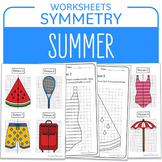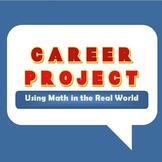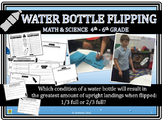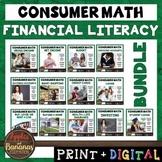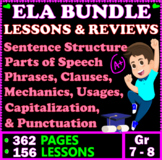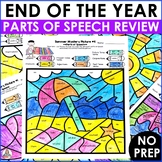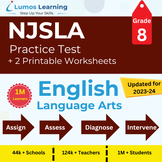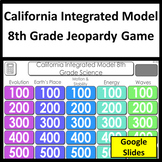11 results
8th grade precalculus laboratories

Make Multiple Vectors Fun! Pirate Treasure Hunt - Physics, Trigonometry
This is one of my student’s favorite activities. Who doesn’t want to go outside and map out some vectors? It works well in physics or trigonometry for understanding how to add and subtract multiple vectors. 10 different maps are provided for student groups to make their way from a single point of origin to a designated, X-marks-the-spot, using compass headings of N, S, E, and W and specified distances. The groups all have a different path but end up at the same place. At the end, students dr
Subjects:
Grades:
8th - 12th, Higher Education, Adult Education
Types:

Vector Treasure Hunt
This activity is designed to teach the students about displacement vectors. There are three parts in four pages. In part II of the lab students make a hunt for other students to follow based on vectors. The next day, students go out, follow the directions and find the "treasure". Very fun activity that teaches the students the basics of vectors. Appropriate for grades 7-12 with an emphasis on beginning physics students.
Subjects:
Grades:
7th - 12th
Types:

Clinometer Discovery Lab (Using Trigonometry)
I gave this project to both geometry and PreCalculus students. I gave them specific directions (included) on how to make a clinometer, but taught them nothing else about how to use them. They had to figure out how to use trigonometry to find the height of some objects in our commons (on a nice day, it would be awesome to go outside). Students used a lot of trial and error, and found how important it was to have an accurate diagram. I checked in frequently with each group-common errors included n
Subjects:
Grades:
8th - 12th
Types:
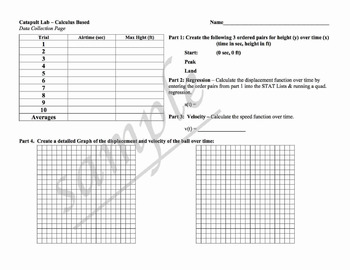
Polynomial Labs (Quadratics, Cubics, etc.) including Catapults!
This lab includes two versions of a catapult lab (calculus based and non-calculus based). Students work in groups to collect data on a ball launched using a catapult. Students create regression equations using a graphing calculator or spreadsheet.
Also included is a painted cubes lab that includes 4 types of functions.
Courses: algebra 1, algebra 2, pre-calculus, calculus
Here are links to my other algebra projects:
Click Here to see my project: Indirect Measurement Labs
Click Here to see
Subjects:
Grades:
8th - 12th, Higher Education, Adult Education
Types:
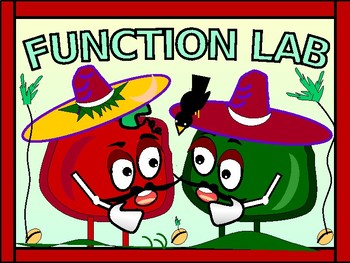
Math Lab:Exponential Functions and Seed Overproduction vs Time/DISTANCE LEARNING
My students totally enjoy doing the following math lab! They invariably find it to be both fun to do as well as informative. They readily relate to discussions within.
* Students work with a partner
* Students begin by a brief discussion about seed overproduction
* Students are provided with assumptions used to complete the lab
* Students work collaboratively to determine the number of seeds in a bell pepper
* Students find the average number of seeds in a bell pepper using the totals
Subjects:
Grades:
7th - 11th, Higher Education, Adult Education
Types:
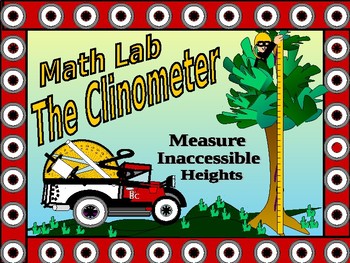
Math Lab: The Tangent Ratio, a Clinometer, and Inaccessible Heights
The following math lab is a follow-up to lessons on the Trigonometric Ratios:* In the lab, students follow steps to create a measuring device called The Clinometer* Students use the Clinometer to measure objects of inaccessible heights such as trees or flag poles.* To measure the objects, students use their Clinometer and apply the Tangent Ratio.* Students work with a partner. * One partner looks through the Clinometer while the other partner records the data required to calculate the tange
Subjects:
Grades:
7th - 11th, Higher Education, Adult Education
Types:
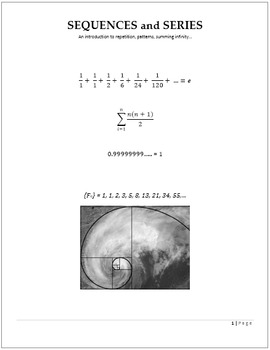
Intro to Sequences and Series Unit
This packet will introduce your students to sequences and series.
It will provide them with many of the useful vocabulary terms.
Introduce them to general, arithmetic, geometric, finite, and infinite sequences and series.
It will instruct them on how to write recursive and explicit formulas, sigma notation for series, tests for convergence of infinite geometric sequences and series, and evaluating finite and infinite arithmetic and geometric series.
This should cover nearly all the material tra
Subjects:
Grades:
8th - 12th
Types:

Math Lab: Investigating Volume/DISTANCE LEARNING/NO PREP
In the following lab, students enjoy a "hands-on" activity to learn the reasoning behind the formulas used in calculating for volume in two solids, the pyramid and the prism.
* Students draw the nets on poster board for a pyramid and a prism, given precise measurements.
* Students carefully cut the nets out and fold according to directions.
* Students use unpopped popcorn, uncooked rice, or dried beans to fill their solids.
* Students compare the volume of a pyramid and a prism with
Subjects:
Grades:
7th - 12th, Higher Education, Adult Education
Types:
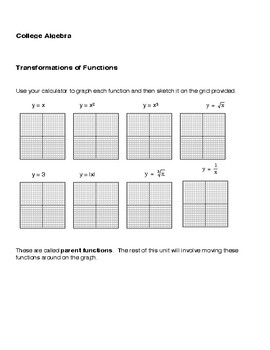
Algebra: Transformations of Functions Lab
This activity can be done alone, at home, or in groups. Using graphing calculators, students first graph parent functions (linear, quadratic, cubic, square root, etc). Then they perform a series of transformations and write down what they notice. This will lead them to the correct conclusion as to the meaning of A, B, C & D in the equation. No key is provided.
Subjects:
Grades:
8th - 12th, Higher Education
Types:
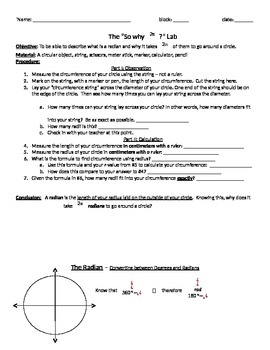
Radian Lab --> Unit Circle
Students use circular objects and string to derive the circumference formula and therefore define what a "radian" is. Students finish by finding a formula for conversion between radians and degrees and complete the Unit Circle in radians.
Subjects:
Grades:
6th - 12th
Types:
CCSS:

Geogebra Photo Functions
This lesson integrates technology to allow students to explore families of functions. Students must know translations of quadratic functions in order to complete this activity. Further knowledge of functions is valuable but not necessary.
This lesson also requires the use of Geogebra--a free interactive geometry software. A web version is available, but the instructions are specific for the Windows downloaded version. This lesson could easily be adapted to any Geogebra version.
CCSS F-BF
3.
Subjects:
Grades:
8th - 12th, Higher Education, Adult Education
Types:
CCSS:
Showing 1-11 of 11 results

